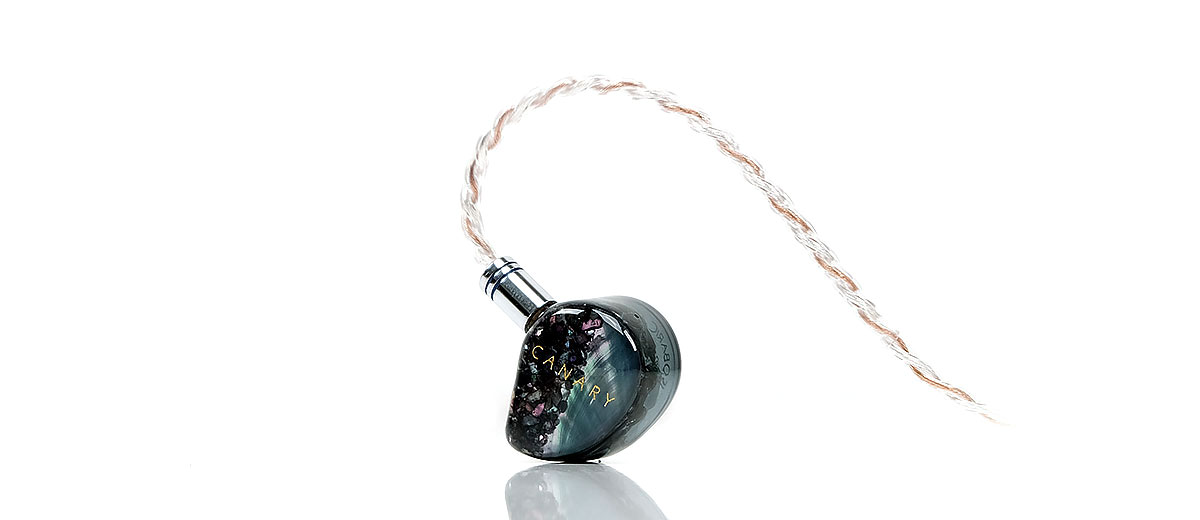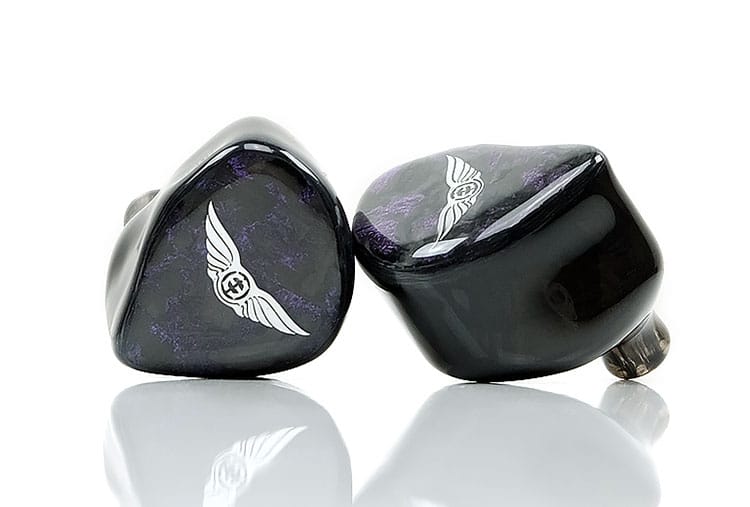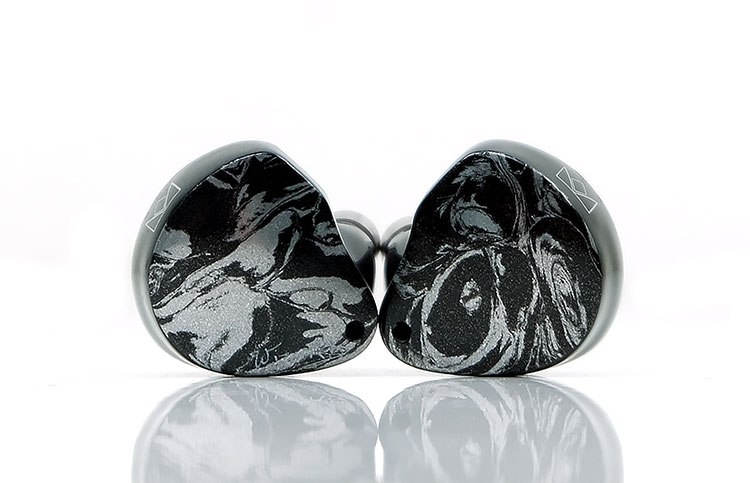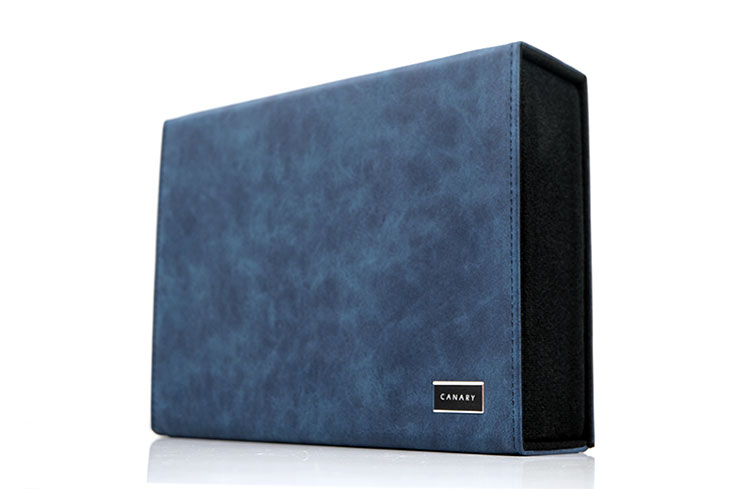Sound Impressions
Summary
The Canary strikes a very different tone from a low of the electrostatic hybrids I have heard to date. Whilst there is no doubt the low-end isobaric driver runs deep and has some nice sub-bass extension, the overall tuning is a lot more linear further up.
Compared to the likes of the Trinity and the Khan the presentation is more L-shaped with a tiny bump around 1-2k and another around 8k. You could argue the effect of the tuning is slightly sub-bass weighted, a bit on the smooth side but otherwise quite neutral and controlled.
What I also like about the Canary is that AAW didn’t play too safe with the electrostatic tuning. There is energy and clarity with some nice excellent articulation but the bias is a bit more to the upper treble than the lower. As such you can clearly hear the extension and there is no shortage of headroom but it also creates more of an ethereal overtone on the higher-pitched instrumental timbre.
This is especially so with synth and orchestral triangles which tend to ring loud and clear but they do not quite have the same solidity as Khan’s more aggressive treble tuning so the odd-harmonic overtone does not reach as deep into the FR and overly upset the mids harmonic balance.
The only weak spot might be the mids where it is decidedly neutral. Vocals do not leap out as much as the aforementioned competitors but on the flip side, the Canary sounds a bit grander or more spacious.
Staging
With that last comment, we roll nicely into the staging and for sure the depth on the Canary is excellent. I have no complaints about the ability of the isobaric driver to drive deep with decent physical quantity. It is not overdone though so while it reaches deep it does not overpower the presentation and muddy up the instrumental clarity in the lower mids.
This is just as well because those mids are fairly neutral with just a faint bump around 1-2k. They tend to push back some of the instrumental positionings somewhat and that does include vocals so it is not an intimate experience by any stretch of the imagination.
The presence tends to be more towards the lower mids than the upper mids also so bass guitar notes are more forward and weighted than, say, tenor vocals.
The staging height on the Canary is excellent. Plenty of headroom and air so it is not a dark sounding experience. Combine that with the neutral mids and you start to get a perception of a wide stage and a slightly grander presentation than more intimate competitors like the Wraith.
Bass
The Canary’s low-end elevation is at its highest sub-100Hz so you get a nice sense of sub-bass power and rumble which, in turn, adds some nice weight to instrumental bass fundamentals.
However, it is not overly aggressive bass tuning and does not pack a huge mid-bass wallop nor is it as potent as something like Empire Ear’s Weapon IX sub-woofer in their Valkyrie hybrid. I would define it as solid, deep but with more of a graceful response than a physical monster.
There is a slow but linear drop from 100Hz down to around 500-600Hz that carries some warmth and body with it. That, in turn, allows instruments kicking in at the lower registers to sound a bit meatier or weightier than the cleaner BA and electrostatic timbre further up the scale.
Mids
I love the lower-mid presentation of the Canary. It carries a nice hue of warmth slipping into guitar timbre without it being what I would call overly thick and oppressive sounding.
I get a sense the FR cut into the lower mids is not that deep or as aggressive as something like the Khan so it is by no means a cool-colored tone with a relatively smooth transition from bass to lower mids helping.
Now beyond that, it will be a preference thing because the mids only have a mildish bump around 1-2k. Vocal timbre, male vocals, in particular, retain that warmth and very natural tone but they are not as far forward as the Wraith or Wavaya’s Octa.
It sounds very refined and accurate with tracks that have a very light instrumental mix but once the instruments get busy with a ton of layered backing vocals, the lead can sometimes lose a bit of focus.
Example
A good example of this switch-up is Ruelle’s Storm single track. Some of you might be familiar with her work as the theme song singer from TV shows such as Shadowhunters and The Shannara Chronicles. On the Storm single, there is a mix of sparse and busy in terms of instrumental presence.
On her own, the Canary is beautiful with excellent detail and a good harmonic balance. You get a wide soundstage, plenty of headroom, and spacing around her vocal delivery. However, around 1:15 to 1:55 the main band kicks in and she loses a little bit of focus and falls back in the mix a bit more.
Vocal lovers might want a bit more, maybe around 2-3dB more, and stretch the stage out a bit more. For orchestral music lovers that won’t be a problem because of that excellent width and the general perception that the Canary creates of being more than a few rows back.
Treble
AAW has allowed the electrostatic monitors here to work a little bit of articulate upper treble energy into the presentation around 7-8k. The lower treble is a bit more relaxed by comparison so it thankfully avoids any sharpness. Percussion timbre does not sound splashy nor do higher-pitched vocals get infused with unnatural sibilance.
However, it is not quite as full-bodied or as wet as the more relaxed Elysium and Trinity treble. Instead, the Canary treble is a cleaner more ethereal sound that tends to tease out a bit of sparkle but not huge amounts of body. Nothing I would define as sharp or overly dry so it is a type of tuning that I tend to enjoy with synth high notes in my hoard of synth wave tracks.
Matchability
Efficiency
You will need to turn up the juice on the Canary. Rated at 100dB SPL it will need a bit more current than non-electrostatic competitors such as the tia Trio and definitely less efficient than the CA Solaris. Mind you, this seems to be the trend for the first-generation electrostatic monitors with the majority of the current demand coming from those dual Sonion tweeters.
The 16Ω impedance is low though so it won’t sound flat or tinny with an excellent dynamic range from any decent-powered DAP from the Sony 1Z, to the higher-powered Cayin N6ii and iBasso’s AMP1 MKII amp card.
Cards such as the AMP 8 with the DX220 are particularly nice thus far with the Canary stock sound. I have a feeling the Canary can scale and I will be curious to hear it from some portable powerhouse amps.
Noise is not an issue with the Canary either. You will find no background hiss with DAPs such as the FiiO M11 or the N6ii from Cayin. Even the iBasso AMP9 card has a fairly low noise floor with the Canary.
Synergy
I tended to find neutral DAPs or those with good dynamic range worked best with the Canary. Of course, you can revert to DSP and PMEQ to fine-tune it now on just about any digital media player but the quality of the amp in terms of resolution is going to be key here.
Range & Resolution
You do not need to worry about relatively high noise floors as the Canary spits out black backgrounds for fun. However, a restrained level of dynamic range will leave the Canary too flat for my liking without DSP.
An example of a match I was not overly fussed about was the stock sound unbalanced from the Cayin N6ii/T01 combo. The mids on this are a little too neutral and lacking in low-end meat to make the Canary come alive. The A01/N6ii combo was much stronger with a thicker bass response and better instrumental timbre. It also has a slightly wetter richer treble response with the Canary compared to something like the Lotoo PAW Gold Touch.
Now the Touch is an interesting pairing. On a personal preference level, I really enjoyed its level of dynamic range and clarity with the Canary. However, the Canary treble reproduction was a little dry and harder sounding than the N6ii. The Canary sounds less fatiguing on the N6ii/A01 but the Lotoo is far more resolving.
The same could be said with the HiBy R5 and the iBasso DX160. I ended up pairing with the DX160 more often for the superior staging and headroom as well as the excellent resolution and imaging. The R5 will put some weight on the Canary low-end and a juicier timbre but I lost a little magic in the upper mids and treble and the pairing felt lacking in air.
Possibly the best pairing was the R2R2000 from Hifiman. The dynamic range and natural tone of the timbre with the Canary were beautiful. With this pairing, I felt the staging took on a far more holographic dimension and every note had some serious “pop”.
Select Comparisons
Jomo Audio Trinity
SG$3,799
Technical
The Trinity is Jomo Audio’s flagship electrostatic hybrid universal monitor. Like the Wraith, the Trinity has 7 drivers with a mix of dynamic, BA, and electrostatic.
The Trinity uses a single 8mm dynamic driver for the lows, 4 balanced armature drivers for the mids and highs, and 2 electrostatic super tweeters. The Canary uses the same configuration however instead of an 8mm DD it uses that dual-diaphragm isobaric driver.
Both are universal custom acrylic hollow body designs with 0.78mm 2-pin connector systems that fit very nicely in the ear. However, the Canary is a shade smaller due to the smaller dynamic driver and has a regular stainless-steel nozzle whereas the Trinity comes with either SS, brass, or black brass nozzles. Each one has a unique sound signature, (this one is brass).
The Canary has the better cable, however. The Trinity uses a fairly generic 1.2m 4-core SPC Litz wire wrapped in a fairly light PET jacket but this does match the internal wiring of the Trinity. The Canary comes with their excellent Symphonym Hakone 26AWG UPOCC Silver/Copper Cable. It is heavier, sure, but it looks the business and handles like a boss.
Performance
The Trinity is rated at a fairly reasonable 30Ω but at a demanding 96dB SPL and compared to the 12Ω and 100dB of the Canary, it is harder of the two to drive on paper.
In real-world testing, I actually found the gap to be negligible between the two in terms of efficiency and current demand overall. The Canary indeed had a very slight edge but the FR or difference in tuning could easily confuse you on which needs more volume.
That makes both the least sensitive in our comparisons, (See Wraith and Khan below), but also the best performers for high noise floors with no DAP creating any perceptible hiss on the Trinity and Canary.
Tuning
Similar driver counts but not a similar tuning. The Trinity is less linear but with a bit more bass/treble contrast. You could contend the Trinity is more u-shaped and the Canary a very slight L-shape in their FR.
I find both the extension and quantity of sub-t0-midbass of these two to be quite similar with perhaps the Trinity just sounding the slightly more elevated of the two below 100Hz and the Canary carrying a touch more warmth up into the upper bass and lower mids.
Mids on both are quite different again. The Trinity is quite elevated from 1-4k compared to the mild 1-2k or otherwise neutral sound of the Canary mids. The Canary mids and vocals will sound a touch more dipped and the staging is pushed back a bit more as a result. The Trinity has a bit more vocal and percussion presence and is more forward and intimate staging quality with instruments tucked in behind.
Both have a clean and clear treble for me but more on the relaxed size in terms of elevation and quantity when compared to the likes of the Khan. The Trinity treble is a bit more excitable for me, the Canary veering to the ethereal and clean side but not quite the weight or presence in the general timbre because of the more controlled midrange elevation.
Overall, the Trinity is more of a colored tuning with plenty of weight on the low-end and mids to upper mids forwardness but a slightly relaxed top-end. The Canary is a little more linear with a slight low-end bias but thereafter quite controlled up to 10k.
Empire Ears Wraith
$3499
Technical
The Wraith is EE’s flagship EP series, an electrostatic hybrid monitor. It also costs a bit more than the Canary but it is packing in a fair amount of hardware including 2 BA for the lows, 3 for the mids, 2 for the highs, and the quad e-stats for the super highs.
The key difference between these two is not really the driver count but rather the Wraith has no dynamic driver. That will change things a little with regards to low-end performance and general timbre.
Build-wise, both are nicely finished hollow-body acrylic universal custom form factors. Both have a single-tone finish with the hue of turquoise and pearl for the Canary and the darker Amethyst Haze of the Wraith.
It is no surprise to me that the heavy driver count of the Wraith means a fairly large shell. The design of both, however, means both are very comfortable in the ear and isolate just as good.
The stock cable is great on the Canary but outstanding on the Wraith with the $699 26AWG Palladium-plated silver Cleopatra from Effect Audio. That is a high class, high-performance cable and double the price of the Symphonym Hakone
Performance
The Wraith is rated at 4Ω and 117dB SPL which is a fairly ridiculous spec on paper compared to the 12Ω and 100dB SPL of the Canary. And yes, in real-world tests the Wraith is the more sensitive of the two monitors.
Our source testing had around a 25-30 step gap between the two monitors on the Lotoo PAW Gold Touch using low-gain unbalanced. We had almost a 20-step gap with the same settings on the HiBy R5.
However, I would not call the Wraith a sensitive IEM in its own right, now like the Solaris or Andromeda. Rather, it is one of the most sensitive electrostatic monitors I have tested to date. Given it has 4 electrostatic drivers compared to the Canary’s two that’s pretty impressive.
Of course, there is the dark side to such sensitivity and yes, the Wraith is more sensitive to high noise floors compared to the Canary. You will pick up noise on the likes of iBasso’s AMP9 card, the FiiO M11, Cayin N6ii A01 combo, and the HiBy R6 Pro. With the Canary, it is pretty much a black background all the way.
Tuning
You will hear some very clear differences between these two flagship monitors. The summary for me is mids and vocal verve for the Wraith and depth or sub-presence weight and height for the Canary.
The Wraith is rocking a BA low-end compared to the dynamic timbre of the 6mm isobaric driver inside the Canary. You get a fast, punchy BA timbre on the low-end of the Wraith but more sub-bass presence, a longer decay, and outright rumble on the Canary.
The Canary low-end is still restrained compared to something like the cheaper Valkyrie Weapon IX driver but you can hear a distinct difference between these two flagships on the low-end. It does mean the Canary is showing off a little more depth, (and height), and combined with the slightly dipped mids it paints a bigger soundstage than the Wraith.
Mids
Mids are more neutral on the Canary with a staging perception of being further back than the front and center Wraith mids presentation. The Wraith lower-mids have some dip to them, but then again so does the Canary to some extent.
The difference is the dip is fairly sustained on the Canary from around 500Hz to almost 1k and then the bump thereafter is a little more nuanced. You could say that the transition is a touch more coherent but the vocals do not leap out as much. They are just as refined but lack a little body and “pop” on the Canary compared to the Wraith.
The Wraith bump from 1-4k is much more noticeable and starts maybe around 600Hz to 800Hz and by the time you hit 2k, you are looking at an 8dB jump. That makes this a more intimate vocal experience and pretty much anything else in that range is going to be given a lot more focus in the Wraith presentation.
Treble
That bump on the Wraith is followed by a marked treble fade from around 5k-6k onwards so it is not the airiest electrostatic I have reviewed to date. It means notes and percussion are a little rounded and lacking in a natural odd-harmonic overtone.
That means cymbals have plenty of ‘thud’ but maybe lack a little splash on the edges to be totally accurate. It is non-fatiguing and quite wet on the flip side.
The Canary is a bit more extended, cleaner and has more treble presence from its dual e-stat configuration. AAW has gone for a bit more bump around 5-6k and 8-10k but not as strong as say the Khan. I find the effect is more ethereal than the wetter Wraith treble.
You tend to pick out more “ting and pling” from triangles than anything super splashy on lower-pitching percussion with the Canary treble.
Noble Audio Khan
$2399
Technical
The Khan is the TOTL electrostatic hybrid monitor in Noble Audio’s universal lineup, (you can get custom also). Like the Canary, it has a blend of three different drivers, but unlike the Canary, it uses a single piezoelectric for the super highs and not dual Sonion electrostatic.
The rest of the configuration is similar with a single DD for the lows and 4 BA for the mids. The dynamic driver on the Khan is a bit bigger at 10mm and does sound a little different than the 6mm isobaric driver inside the Canary.
Build on both are hollow-body acrylic with the Khan using a nice M3 composite twist on the traditional Mokume Gane metallurgy process for the faceplate. The body is not quite as custom universal shaped as the Canary but instead provides a longer nozzle.
The tips on the Khan are therefore a little more critical in terms of comfort and seal. The Canary isolates a little better for me with its more aggressive contouring and a closer fit.
Performance
Noble never really provides their performance numbers so we tend to guess relative to other competing IEMs. Our previous review had it around 20-30Ω and 105dB SPL, possibly as close as 110dB SPL.
In our real-world testing, the Khan was much easier to drive and much more sensitive to current than the 100dB SPL of the Canary.
We tested them both with a Lotoo PAW Gold Touch on the high-end and a HiBy R5 mid-fi DAP with both offering very good power ratings. The Canary needs a good 15-20 volume steps more in unbalanced low-gain on the Touch compared to the Khan and about 10 on similar settings on the R5.
I am putting the gap down to the use of a single piezoelectric driver compared to the more demanding dual Sonion electrostatic drivers inside the Canary. Both are not sensitive enough, however, to pick up on background hiss on any high noise floors. Both have nice black backgrounds on the likes of the Cayin N6ii, the R6 Pro, and the FiO M11 using balanced.
Tuning
The tuning and timbre on the Khan are more on the vivid, cooler but edgier side. Matching is a little more studied with the Khan because of its forward treble presence and slightly more aggressive low-end dynamic driver tuning.
Treble
I do love the piezoelectric treble on the Khan because it reminds me of how an electrostatic headphone generally sounds, intense but very solid. You do not get any of that peaky BA timbre like it is being pushed to the limit but it does have a more strident tone than the Canary electrostatic tuning.
The Canary tones it down so its timbre is a touch warmer further down the FR but in turn, the treble is a more ethereal clean but lean sound. You will find the Canary the easier of the two to match and maybe less fatiguing but I still feel Noble has given us the truest treble on e-stats hybrids to date.
Mids
Mids are more forward on the Khan, the Canary is still relatively neutral, especially vocals. The 1-3k range on the Khan is noticeably more elevated. The timbre is edgier though and you do pick up on those odd-harmonic overtones a lot more on the Khan.
The Canary is more controlled, smoother, and the wetter of the two in the mids. If you want vivid focused vocals to the fore and can handle that harder tone then the Khan is a good choice. If not then the Canary’s more nuanced and neutral control is the more forgiving choice.
Bass
Both have a very distinctive dynamic driver low-end response and timbre with a slightly slower decay and nice rumble. The Khan has more sub-bass quantity and rumble though and just edges it for me in terms of power.
The Canary has a bit more warmth and has a more linear drop into the mid-bass and lower-mids. It does sound a little more coherent and balanced compared to the more exciting and impactful bass Khan delivery.
Our Verdict
So, where do we place AAW’s debut electrostatic hybrid monitor in a fairly competitive field right now? Well, I would have to consider the AAW Canary to be a detailed all-rounder or the “Michael Chang” of audio as I like to think of it. It lends itself well to a wide range of genres with perhaps vocal focus the weakest point in an otherwise excellent performance.
The defining characteristic of the Canary is that excellent isobaric driver with its strong depth and presence but without sounding like a 15″ sub stuck in the back of a Mini Cooper. Hard to believe this is a tiny 6mm driver. Especially compared to some of those huge 13mm alternatives in other hybrids.
For those that want a bit of reach at both ends and enjoy sitting a few rows back to their music then the diminutive but elegantly tuned Canary is an excellent fit.
AAW Canary Specifications
- Frequency Range: 5-100,000 Hz
- Nominal Impedance: 12 ohms
- Sound Pressure Level: 100 dB






